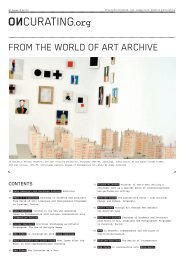You also want an ePaper? Increase the reach of your titles
YUMPU automatically turns print PDFs into web optimized ePapers that Google loves.
033 Issue # 11/11 : PublIc Issues<br />
Trialectics of spatiality<br />
The relational space model of the French philosopher and<br />
sociologist Henri Lefebvre h<strong>as</strong>, since the 1990s, changed the<br />
understanding of space in many disciplines (Lefebvre 1974).<br />
The thoughts on space of the American social geographer<br />
and urban planner Edward Soja advanced Lefebvre's ide<strong>as</strong>,<br />
introducing a trialectics of spatiality in which three<br />
<strong>as</strong>pects of equal value were brought together to constitute<br />
space: sensually perceptible space, i.e. materially built<br />
space (perceived space); imagined, calculated or abstract<br />
space, the space of images and models (conceived space);<br />
and the space in which things are lived and experienced,<br />
the social space (lived space) (fig. 1). Only these three<br />
<strong>as</strong>pects together yield space, or <strong>as</strong> Lefebvre says: produce<br />
space (Soja 1996). Space, and thus also public space, is<br />
a social product.<br />
Since space is a social product, so are cities. Cities first<br />
emerge when people perceive the existing material struc-<br />
tures there with their senses, use it and appropriate it.<br />
Individual perceptions are filtered through a manifold<br />
network of ide<strong>as</strong>, memories and images in the mind of the<br />
perceiver, are coloured and composed into a temporary super-<br />
ordinate total event. Each action resulting from this<br />
intervenes in the city's form and thus modifies the setting<br />
for those who constitute the urban space. Thus, the entire<br />
urban material and symbolic ensemble is in constant trans-<br />
formation and must continually be recreated, i.e. produced<br />
by residents in an active process. Hence the city is an<br />
expression of continual discontinuity.<br />
The same applies to streets: built streets are part of the<br />
city's material structure. While their me<strong>as</strong>urable material<br />
form cannot be changed, they are lively <strong>as</strong> space. The space<br />
of a street appears in a different form depending on usage<br />
and appropriation, action and interaction, on the time<br />
of day or the time of year. Street space – one of the l<strong>as</strong>t<br />
public spaces – is not fixed and rigid but dynamic, a pro-<br />
duct of social action.<br />
When we observe life on the streets of a city, it becomes<br />
apparent that the activities on the pavements and small<br />
side streets are often more intense and varied than on many<br />
new very aesthetically designed squares. In Asian cities,<br />
the streets have formed the b<strong>as</strong>is for urban life for centu-<br />
ries. The idea of the square <strong>as</strong> the place where people<br />
gather is a Western one. In India, China and Japan there<br />
didn't use to be any squares. The place for ceremonies and<br />
festivals w<strong>as</strong> always the street (Kurokawa 2005). This<br />
seems to be one re<strong>as</strong>on why many newly built squares in Japan<br />
don't function well. They are not – or not yet – part of<br />
the culture.<br />
This raises some important questions. What exactly is public<br />
space in Japan and China? What takes place in public, and<br />
private, space? How are the two separated from one another?<br />
Or to go even further: Can we even speak of private and<br />
public space in Japan and China? These issues will now be<br />
addressed.<br />
From XXL to XXS – the structure of Tokyo<br />
Approximately 34 million people live in the Tokyo metropoli-<br />
tan area. As a result, many envision Tokyo <strong>as</strong> a monstrous<br />
metropolis with countless high-rises and imp<strong>as</strong>sable motor-<br />
ways. However, even a cursory glance at a map of the city<br />
shows that this impression is not entirely accurate. Un-<br />
like the much smaller city Berlin, Tokyo h<strong>as</strong> a very finely<br />
structured road system (fig. 2, 3). Large through roads,<br />
many of which are elevated highways, branch out into two-<br />
to four-lane main roads that enclose residential are<strong>as</strong><br />
(fig. 4). Within the latter, there is a further refinement<br />
of the road system into smaller access roads and resi-<br />
dential side streets. Some of them have speed limits and<br />
1 — Trialectics of space according to Edward Soja /<br />
Trialektik des Raums von edward soja<br />
2 — Berlin street grid (detail) / str<strong>as</strong>senr<strong>as</strong>ter<br />
berlin (Detail)<br />
3 — Tokyo street grid (detail) / str<strong>as</strong>senr<strong>as</strong>ter<br />
Tokyo (Detail)


![Download as PDF [10.6 MB]](https://img.yumpu.com/4266533/33/500x640/download-as-pdf-106-mb.jpg)

